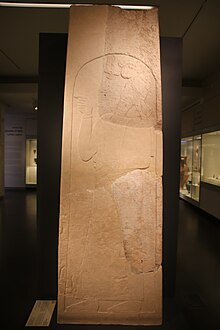Iran Stele
| Iran Stele | |
|---|---|
 The Iran Stele on display at the Israel Museum, 2018 | |
| Material | Dolomite (rock) |
| Height | 240 cm (94 in) |
| Writing | Akkadian |
| Created | c. 737 BCE |
| Period/culture | Reign of Tiglath-Pileser III of the Neo-Assyrian Empire |
| Discovered | Zagros Mountains, Iran |
| Present location | Jerusalem, Israel |
| Period | Iron Age |
The Iran Stele is a stele from the Neo-Assyrian Empire.[1][2][3][4][5] Dated to around 737 BCE, it is written in Akkadian and was discovered in the Zagros Mountains of Iran, hence the name.
The Assyrian king Tiglath-Pileser III was instrumental in expanding the Neo-Assyrian Empire westward, reaching the Levant and encountering Israel and Judah.[6] The Iran Stele was discovered in three large fragments and details his military campaigns during the first nine years of his reign.[7]
Of particular interest to ancient Israel is a section of the inscription listing the kings who paid tribute to him, including Menahem of Samaria.[8] Two of the Iran Stele fragments are now housed at the Israel Museum in Jerusalem after being part of various private collections.[9]
Text:
“Menahem of Samaria, Hiram of Tyre, . . . gold, silver . . .”[10]
“. . the place of Samaria only did I leave their king”[11]
References
- ^ The Inscriptions of Tiglath-Pileser III, King of Assyria. Hayim Tadmor. 2007. ISBN 978-9652081759.
- ^ "Stele of Tigla...Stele of Tiglath-Pilesar III (biblical Pul), founder of the Assyrian Empire". museums.gov.il.
- ^ "Archaeological Evidence of Kings of Israel and Judah". ArmstrongInstitute.org. Retrieved 2024-03-31.
- ^ Hayes, John H.; Hooker, Paul K. (2007-06-08). A New Chronology for the Kings of Israel and Judah and Its Implications for Biblical History and Literature. Wipf and Stock Publishers. ISBN 978-1-7252-2007-2.
- ^ Vcyamerica (2019-06-29). "June 29 – Tiglath Pileser III". VCY.org. Retrieved 2024-05-03.
- ^ "Tiglath-pileser III 35 [via RINAP/RINAP1]". oracc.museum.upenn.edu.
- ^ "Iran Stele, 737 BCE : Center for Online Judaic Studies". Retrieved 2024-03-13.
- ^ "Stele of Tiglath-Pilesar III". www.imj.org.il. Retrieved 2024-03-13.
- ^ "RINAP 1 Tiglath-pileser III 35, ex. 001 (P429999)". CDLI. Retrieved 2024-03-13.
- ^ "The Annals of Tiglath-pileser - Livius". www.livius.org. Retrieved 2024-03-17.
- ^ "The Syro-Ephraimite War and its implications" (PDF).
